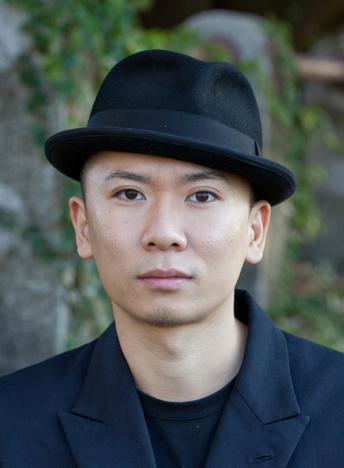丸若裕俊Hirotoshi Maruwaka

© Maruwaka. Photo: Koichiro Kutsuna
The Kamide Kutani Keigo Exhibition, “KUTANI CONNEXION” (Spiral, Omotesando) and “Medicine and Art” (Mori Museum, Roppongi) are some of the exhibits for which Kamide Choemongama‘s Kamide Keigo is garnering attention上出・九谷・惠悟展 「九谷焼コネクション」(表参道/スパイラル)、「医学と芸術展」(六本木/森美術館)などで注目を浴びる上出長右衛門窯・上出恵悟。そこには、日本の伝統工芸を新たな視点で現代に蘇らせようとしている、若きプロデューサーの丸若屋代表・丸若裕俊がいる。2009年のデザインタイドでは印傳(いんでん)という、数百年に渡り日本に伝わる鹿革に漆でプリントをした工芸を使用し、浅草の職人と共にデザインしたiphoneケース「otsuriki」を発表。一躍、丸若屋という存在を知らしめた当人だ。自らを民芸オタクだと話す丸若の、ものづくりへの熱き思いを伺った。
![]()
![]()
伝統工芸にかかわるきっかけはどういうものだったのでしょうか?
![]()
ある時、人を介してご紹介いただいた九谷焼が最初のきっかけです。根本的に僕は、手仕事であったり日本の文化というものに対して興味があり、好きっていう気持ちが強かったので。例えば、子供が仮面ライダーを見て熱狂するじゃないですか。それと同じように日本のものを見たときに、僕はこれは古いもの、これは新しいもの、これはつくられているもの、こっちは文化的なものっていう概念がないので、簡単にいうとヤバイかヤバくないかっていう。その時に仮面ライダーよりもヤバかったんですよ、単純に言えば。それが年代を追うごとに、実は自分たちのDNAの中に本当は実在していたものだっていうのに気づいた時のショックというか、衝撃があったんです。自分の何代前かわからないですけど、おじいちゃんとかがちょんまげをしてたってことに気づいて。これは途切れるのがもったいないなっていうのがありました。
![]()
![]()
そういうことに敏感に反応できる感受性というか、そういう素地が人一倍強かったから実際こういう活動に繋がっていったのですね。日本人であれば、みんながそういうDNAを受け継いでいるわけで、それが丸若さんほどの行動力をもってここまで形にして発信しているのは、何が違うからだと思いますか?
![]()
僕が育った地域が横浜の中華街で、絶えず多国籍な環境にさらされてたんです。そんな中で子供ながらに、日本人というものに対してすごく意識が出てきた。僕は海外の文化は素晴らしいものだと思うんです。でも、日本人の文化は少なくともそれに負けてるものではないと間違いなく思う。それなのに、日本の若い同年代の多くは、そっちに興味を持ってくわけじゃないですか。それにすごく疑問を持ったんですよ。僕は全然海外生活もないんですけど、多国籍な中で育ったってこともあって、海外の人たちに対してコンプレックスがないんです。外人の見た目がかっこいいのはわかりますけど、彼らがちょんまげしたらかっこいいのかっていうとかっこよくないわけで(笑)。だから日本人らしいかっこよさっていうのがあると思うんですよね。それはすごい、国際基準になると思うんです。いくら日本人がイタリアのスーツを着ても、それは何て言うか演歌を歌ってる外人にしかならないわけですよね。根底にはかっこよくなりたいっていう願望はあると思うんです。その規模感がセンター街でかっこいいと言われたいのか、東京でなのか、日本なのか、国外なのかっていう規模感の問題だと思うんですよ。僕は、大きいとか小さいとかではなくて、どこに行っても誇れる感じっていうか。どこの国に行っても何をやってるって言えるし、何をつくってるというのも言える。それがすごくストレスがない状態ですね。
![]()
![]()
2010年GDPも中国に抜かれる、一方ではものづくりの工程がファスト化され極度に加速化するなど、日本のものづくりの環境もグローバル社会の中で大きな変容を迫られていると思います。その中で、日本のものづくりの進むべき方向性についてはどう思いますか。丸若屋の今後の活動についても教えてください。
![]()
僕らや職人さんがつくっているものは文化であり、民族性が集約されてるものなんです。実はコンセプトを形にしているんですよね。ものをつくってるようで、ものづくりじゃないんですよ。ハードなものじゃなくて、ソフトなものをつくってる。例えばこのコップがイケアで100円で売っています。でも、薩摩切り子では100万円するとします。なぜか。それは付加価値がつくから。まず、付加価値っていうのはソフトウェアであることを僕は自覚したい。ハードに比べたらモデルチェンジは遅くていいんです、概念なんで。それがひとつ僕の考え方であるのと、だからこそ10年、20年耐えられるものをつくらないとならない。概念なので。その間にちっちゃいマイナーチェンジだったりがあってもいいと思うんですよ。だけど、携帯電話のモデルチェンジと同じスピード感で市場に入っていっても無理なわけです。伝統工芸はハードな部分に囚われすぎるのではなく、精神的な部分を大切に広めていくのであれば、形はちょこちょこ変わったとしても本質は変わらないと思うんですよ。だから今のような物質社会が崩壊したときにこそ、精神性や概念といったソフトな部分が重要視されると思うんです。
今後の活動としては印傳(いんでん)は形を変え、生活に馴染むもので色々やっていきたいというのと、素材としての伝統工芸をもう一度見つめ直すのもいいんじゃないかと思っていて、そのプロジェクトをやっていきたいです。
![]()
![]()
東京でおすすめの場所はどこですか?
![]()
一定のジャンルというのでは無く、自分達の目を信じて作られた場所が好きです。例えば、駒場の「日本民藝館」や浅草にある「宮本卯之助商店」という祭事用品の老舗等はすごく栄養補給になる場所ですね。
人生をかけて形づくった場所や世界観というのはすごく勇気をいただける場所。それから、意味合いは違いますが上出くんに紹介してもらった「EXPO」っていう鶯谷の方にある骨董屋があるんです。そこへ行くとすごくテンションが上がるというか、ワクワクするんですよね。変な美術館に行くよりもよっぽど面白いですね。
![]()
![]()
丸若屋 (まるわかや)
住所:東京都世田谷区中町1-20-6 #201
TEL:03-6318-7431
info@maru-waka.com
http://www.maru-waka.com
![]()
Text: mina. At the center of this effort to revive Japanese traditional crafts for the contemporary crowd from a new perspective is the young producer Maruwaka Hirotoshi, the representative of Maruwakaya. At DESIGNTIDE 2009, he unveiled “otsuriki“, an iPhone case co-designed with Asakusa artisans using inden, a Japanese craft of lacquer printing on deer skin, which is an art dating back several centuries. He is responsible for spreading the Maruwakaya name. Describing himself as a folk crafts otaku or geek, Maruwaka spoke of his passion towards monozukuri, or the art of making and creating.
![]()
![]()
How did you get involved in traditional crafts?
![]()
I was introduced to Kutaniyaki through some people, and that was my starting point. I was already interested in handiwork and Japanese culture, and was strongly drawn to the field. I would look at something Japanese the way most children may be interested in superheroes. At the time, I was not able to conceptualize whether something was old or new, if it was something artificial or cultural, but I just knew if something was hot or not. Back then, these objects were hotter than superheroes for me, simply put. As I grew up, I found out that Japaneseness was actually in our DNA, and that actually shocked me—to learn that my own ancestors, how many ever generations back, wore their hair in samurai-style. I felt that it would be a waste to end this ancestral line.
![]()
![]()
You probably have a stronger aptitude or sensitivity towards Japanese culture that led you to work in this field. All Japanese people have this “DNA”, but what do you think is different about you that made you this active in disseminating such tangible ideas.
![]()
I grew up in Yokohama’s Chinatown. I was always in a multinational environment. Even as a child, I was very conscious about Japanese people. I think foreign cultures are fantastic. But there is no doubt in my mind that Japanese culture should be considered any less than other cultures. And yet, young people of my generation in Japan turned towards the latter. I was very suspicious of this. I have never lived abroad, but since I grew up in a multinational environment, I have no inferiority complexes or hang-ups regarding foreigners. I recognize that foreigners can look very cool. But if they wore their hair in samurai-style, they probably won’t look too cool (laughs). That’s why I think there is a Japanese coolness, which I think can be a significant international standard. Even if a Japanese man wears an Italian suit, he will always be like a foreigner singing Japanese enka (folk ballads). I think at the very core, there is a yearning to look cool. But it is a question of whether we are talking about cool on the streets of Shibuya, cool by Tokyo standards, cool in Japan, or abroad. For me, it is not a matter of size—big or small—but the ability to hold my pride wherever I am. I can go to some foreign country and still say what I do and what I make. This makes for a very stress-free situation.
![]()
![]()
In 2010, China is going to outrank Japan in GDP, the manufacturing process is accelerating at an extreme pace, and Japan’s monozukuri is under pressure to transform in a global society. In such conditions, what do you think is the direction for Japan’s monozukuri? Please also expand on the future of Maruwakaya’s activities.
![]()
What we, along with artisans, are making is culture, and we are consolidating ethnicity in it. We are simply realizing concepts. It appears like it’s monozukuri, but it isn’t monozukuri. We are not making concrete objects, but soft concepts. For example, a glass is on sale at IKEA for 100 yen. But a Satsuma Kiriko (a Japanese glassware tradition from Kyushu) glass costs 1 million yen. Why is that? It’s because there is added value. First of all, I want to recognize that added value is a soft concept. Compared to hardware, model changes can be slower, because it is a concept. This is one of my understandings. That is why we have to produce items that can last 10 or 20 years, because they are concepts. There can be minor changes along the way, but we cannot enter the market with the same speed that cellular phone models change. Traditional crafts should not be bound by their hardware or concrete shapes. As long as we nurture the inner, spiritual aspects, even if their outward appearances transform, their essence will not change. That’s why if the current material society collapses, the soft side, the spiritual concept will become much more important.
As for future projects, inden will change a bit, and work with everyday objects. I also want to reconsider traditional crafts as a subject matter, so that’s a project I want to work on.
![]()
![]()
Could you share your recommended places in Tokyo with us?
![]()
Japan Folk Crafts Museum and Miyamoto Unosuke Co., Ltd. are significant spots where become a source of my creation. They are places where give me great courage, as it was created by devoting lives of people in the past to believe and rediscover what they have done. Another exciting place is an antique shop in Uguisudani called EXPO, where is very interesting place to visit rather than visiting to odd museums.
![]()
Maruwakaya
Address: #201, 1-20-6 Nakamachi, Setagaya-ku, Tokyo
Tel: 03-6318-7431
info@maru-waka.com
http://www.maru-waka.com
![]()
Text: mina
Translation: Makiko Arima丸若屋
地址:東京都世田谷区中町1-20-6 #201
电话:03-6318-7431
info@maru-waka.com
http://www.maru-waka.com
![]()
